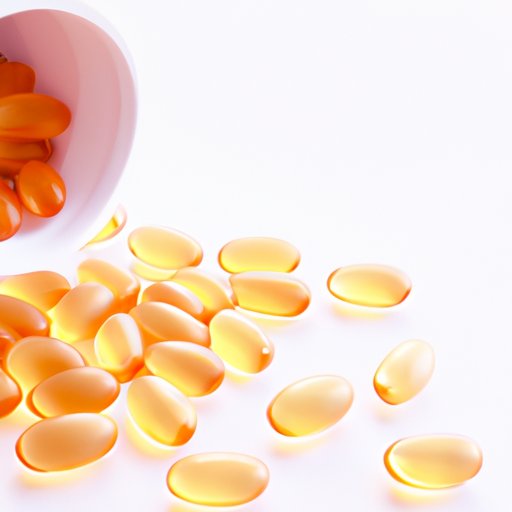
I. Introduction
Vitamin D is an essential nutrient that plays a crucial role in various bodily functions, including maintaining strong bones, regulating immune function, and reducing inflammation. Despite its importance, however, many people don’t get enough of it. In fact, vitamin D deficiency is a global health problem affecting people of all ages and backgrounds.
The purpose of this article is to explore ways you can absorb vitamin D effectively. By the end of this article, you’ll gain a better understanding of the daily recommended intake of vitamin D, sources of vitamin D, and ways to maximize its absorption into the body.
II. Getting Your Daily Dose: Top Strategies for Absorbing Vitamin D
To maximize vitamin D absorption, it’s essential to know the recommended daily intake. Experts suggest that individuals aged 1-70 should consume at least 600 IU (International Units) of vitamin D per day, while those above 70 years should increase the intake to 800 IU.
Food sources like salmon, swordfish, tuna, egg yolks, and mushrooms provide a good amount of vitamin D. Fortified foods, such as milk, orange juice, and cereal, can also help boost your daily intake. Vitamin D supplements are also a viable option, especially for people with low vitamin D levels and those living in areas with limited sunlight.
III. Unlocking the Benefits of Sunlight: Best Practices for Maximizing Vitamin D Absorption
Sunshine is another excellent natural source of vitamin D. When exposed to sunlight, your skin produces vitamin D3. It’s then absorbed into the bloodstream, where it’s converted into an active form of vitamin D that the body can use.
The amount of sun exposure required to produce enough vitamin D depends on various factors such as skin color, age, and geographic location. Generally, exposing your skin to sunlight for at least 10-20 minutes a day, two to three times a week, should be sufficient for most people.
It’s also crucial to avoid peak sunlight hours to prevent sunburn and skin damage. Experts recommend morning or late afternoon sun, as the sun’s rays are less intense at these times.
IV. From Food to Supplements: Practical Tips for Optimizing Your Vitamin D Intake
Choosing vitamin D-rich foods like salmon, shrimp, egg yolk, and yogurt can make a significant difference in reaching your daily intake goal. Additionally, vitamin D supplements can help meet the recommended daily dose to address deficiency concerns.
When selecting vitamin D supplements, it’s essential to read the labels carefully and look for reputable brands. Vitamin D in supplements comes in two forms: D2 and D3. The latter is more effective in raising your blood levels of vitamin D. Taking too high doses of vitamin D supplement may lead to its toxicity and can cause harm. As a result, it’s crucial to consult your health provider when deciding on the appropriate dosage for your condition.
V. The Science of Sun Exposure: How to Safely and Effectively Absorb Vitamin D
While vitamin D is essential, excessive exposure to sun rays can also have harmful effects on the skin. To reap the benefits of sunlight and maximize vitamin D absorption while staying safe, it’s crucial to follow a few guidelines.
The use of sunscreen is recommended to protect the skin while still allowing vitamin D production to occur. However, it’s essential to select a sunscreen brand that doesn’t inhibit vitamin D synthesis. When applying sunscreen, remember to follow the instructions and apply liberally to all exposed skin.
People sensitive to sunburn can enjoy the sun without incurring burnt skin by wearing sun-protective clothing or headgears like hats and caps. It’s crucial to avoid too much sun exposure. Intermittent exposure to sunlight or taking breaks to cool down can also prevent the likelihood of sunburn and provide a chance to reapply sunscreens when necessary.
VI. Breaking Down Barriers: Overcoming Factors That Can Impede Vitamin D Absorption
Some factors can impede vitamin D absorption in the body, including obesity, certain medications, and malabsorption disorders. Obesity can decrease vitamin D absorption due to the fat-soluble nature of vitamin D. Certain medications, such as those used to treat acid reflux, can affect vitamin D absorption. Malabsorption disorders, such as Crohn’s disease, celiac disease, and ulcerative colitis, can also decrease absorption. Treatment of obesity, underlying malabsorption disorders, and switching certain medications can remedy absorption problems.
VII. Conclusion
Vitamin D plays a crucial role in various bodily functions, and maintaining optimal levels of vitamin D is crucial for overall health and well-being. By adding vitamin D-rich foods to your diet, soaking up just the right amount of sunlight, and considering vitamin D supplements, you can begin to reap the benefits of this essential nutrient.





